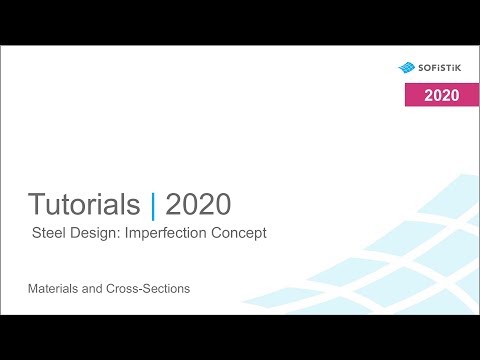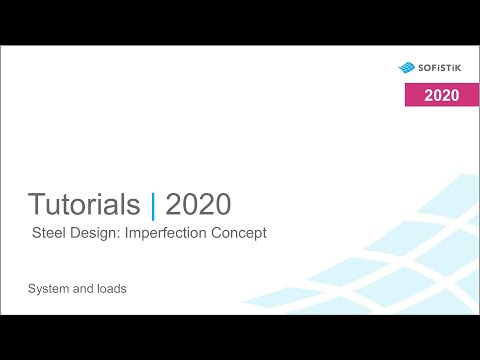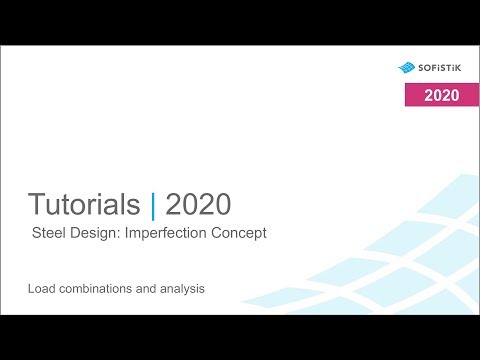Imperfection concept#
Introduction#
This document provides a short introduction to the general stability approach based on imperfections and second order analysis, which is allowed according to EN 1993-1-1. This tutorial will focus only on the imperfection problem, but not on the design of elements. Design topics are described in other tutorials such as Portal Frame. A simple steel frame is analysed in this tutorial.
This project is fully done using Graphical User Interface (GUI). However, it could be completely reproduced via text input - CADINP language. The intention of this tutorial is to guide you through a simple single-span frame example and introduce the general work-flow for imperfections in SOFiSTiK.
Hint
This tutorial is based on EN 1993-1-1 and EN 1993-1-5.
Tip
If you click on the figure it will show up in original size.
See also
For more details see Imperfection Concept - Theoretical Background
Objectives#
Generate loads inside SOFiPLUS
Run linear analysis
Generate load combinations
Run second order analysis
Project Description#
Geometry#
A simple one-span steel frame is presented. The frames are on a 5 m spacing. The frame height is 5000 mm with a span of 6000 mm.
Materials#
Number |
Grade |
Notes |
|---|---|---|
1 |
S 355 (EN 10025-2) |
tf < 16 mm, thus fy = 355 MPa |
Cross-sections#
Number |
Title |
Notes |
|---|---|---|
1 |
HEA 200 |
For whole frame |
Loads#
Number |
Title |
Action |
Load Value |
|---|---|---|---|
1 |
Self-weight |
G (Permanent) |
Automatically generated |
2 |
Dead load |
G (Permanent) |
1.0 kN/m2 |
3 |
Imposed |
Q (Variable) |
2.0 kN/m2 |
4 |
Wind load +Y |
W (Variable) |
1.0 kN/m2 |
5 |
Wind load -Y |
W (Variable) |
1.0 kN/m2 |
11 |
Imperfection |
IMP (Imperfection) |
Sway 1/200, bow 1/200 (stress-free) |
Loadcase 2
Loadcase 3
Loadcase 4
Loadcase 5
Loadcase 11
Load combinations#
Number |
Title |
Permanent |
Leading Variable |
Accompanying Variable |
|---|---|---|---|---|
1001 |
1.35·LC1+1.35·LC2+1.50·LC3+0.9·LC4+1.0·IMP |
1.35 |
Imposed 1.5 |
Wind 1.5 · 0.6 |
1002 |
1.35·LC1+1.35·LC2+1.50·LC3+0.9·LC5-1.0·IMP |
1.35 |
Imposed 1.5 |
Wind 1.5 · 0.6 |
1003 |
1.35·LC1+1.35·LC2+1.05·LC3+1.5·LC4+1.0·IMP |
1.35 |
Wind 1.5 |
Imposed 1.5·0.7 |
1004 |
1.35·LC1+1.35·LC2+1.05·LC3+1.5·LC4-1.0·IMP |
1.35 |
Wind 1.5 |
Imposed 1.5·0.7 |
Step-by-Step#
Materials and cross-sections#
Title: Materials and cross-sections | Quality: 1080p HD | Captions: English
Generate loads inside SOFiPLUS#
Title: Generate loads inside SOFiPLUS | Quality: 1080p HD | Captions: English
Load combinations and analysis#
Title: Load combinations and analysis | Quality: 1080p HD | Captions: English
After the system is exported to SSD, the user can open the task Linear Analysis to run the linear analysis of load cases. It can be seen that the imperfection loadcase is not supplied for this task. Imperfection is only available in analysis according to the 2nd (or 3rd) order theory. Imperfection cannot be used for a linear analysis of single loadcases.
Note
A loadcase Imperfection is defined with TYPE IMP. The loadcases of this type allow
the use of imperfection loads for the definition of loadcase combinations for
the analysis according to the second (third) order theory. It is meaningless to
use imperfection loadcases for a linear analysis of single loadcases
with ASE or STAR2 and to superimpose these linear loadcases with
MAXIMA, as imperfection alone does not create any additional effects, unless a second order
analysis is performed. For imperfections the program is capable to handle a cubic function
distribution directly for a single beam.
The same is valid for text input. If a linear analysis has been chosen with SYST PROB LINE
and all loadcases are chosen with LC NO ALL, the solver will ignore the imperfection loadcases.


